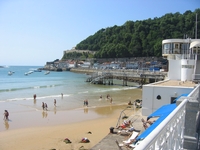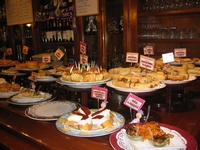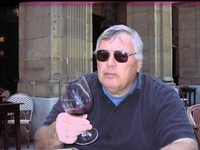 SAN SEBASTIAN, Spain — I have only checked into the Maria Cristina a few minutes ago and am already bellied up to the tapas bar at Casa Urola, in the Old Town. The streets are teeming with visitors from across the globe, drawn by the sun, the sea and the cuisine of this stunningly beautiful seaside enclave in the heart of the Spanish Basque country.
SAN SEBASTIAN, Spain — I have only checked into the Maria Cristina a few minutes ago and am already bellied up to the tapas bar at Casa Urola, in the Old Town. The streets are teeming with visitors from across the globe, drawn by the sun, the sea and the cuisine of this stunningly beautiful seaside enclave in the heart of the Spanish Basque country.
This is the center of the culinary universe, for me at least. The succulent clams of this region, often prepared simply with parsley, butter and a splash of white wine, are the sweetest in the world. Grilled hake or turbot — brought in this morning by the fishing boats tied up in the port mere steps away — is so fresh and tender it melts in the mouth.
The tapas, known locally by their Basque name, "pintxos," are considered the finest in all of Spain, a point of pride among the locals and a commonly held belief I wouldn’t care to debate. Fond as I am of the tapas bars that border Madrid’s Plaza Santa Ana, the Old Town of San Sebastian is second to none on this score.
As I stand here at Urola and contemplate my next tapas selection, it occurs to me that this is a wine enthusiast’s paradise, for this is the combination of wine and food as it was meant to be, as it should be. There are few frills: just great food and good wine.
 Even with limited Spanish speaking skills, it is easy to quench the palate. Red wines are "tinto," white wines "blanco" and rose wines "rosado." So I point at a "pintxo" — or, if I am feeling bold, just lift it by its toothpick and devour it in one bite — and ask for a "copa de vino blanco," or whatever my preference is depending upon the tapa I have ordered.
Even with limited Spanish speaking skills, it is easy to quench the palate. Red wines are "tinto," white wines "blanco" and rose wines "rosado." So I point at a "pintxo" — or, if I am feeling bold, just lift it by its toothpick and devour it in one bite — and ask for a "copa de vino blanco," or whatever my preference is depending upon the tapa I have ordered.
It doesn’t much matter what they pour. Most of the reds are Rioja crianza, while the whites are invariably Verdejo from Rueda and the rosados Garnacha from Navarro. Price for a copa of wine is cheap, typically one euro, about $1.50, in the tapas bars and one to two euros at the many outdoor cafes.
I sometimes recognize the producers, but frequently don’t. Yet I almost always find the wines to be solid and quaffable, a perfect accompaniment to the array of aromas and flavor sensations I encounter even at the most modest tapas bar.
 San Sebastian also boasts a number of nouvelle culinary stars, such as Arzak and Martin Berasategui, both with three Michelin stars. I’ve also been to Chef Berasategui’s Michelin one-star in Barcelona, Lasarte, and am very much looking forward to lunch at his namesake restaurant here in San Sebastian.
San Sebastian also boasts a number of nouvelle culinary stars, such as Arzak and Martin Berasategui, both with three Michelin stars. I’ve also been to Chef Berasategui’s Michelin one-star in Barcelona, Lasarte, and am very much looking forward to lunch at his namesake restaurant here in San Sebastian.
Urola is a more traditional Old Town restaurant, with a tapas bar on the first floor, where the doors are thrown open to the crowds on the street, and a full-service restaurant upstairs, where reservations are recommended. Juanito Kojua is another traditional restaurant serving up grilled seafood and meats in the Old Town. Basque cooking is unique and you shouldn’t miss the "changurro," a rich, stew-like dish made with spider crab and spooned over crusty bread.
Though Juanito is not as popular as Urola, and hence not as busy, I still suggest you make reservations before you go.
Getting to San Sebastian is the hard part, though it’s not nearly as challenging as you might imagine. There are two trains a day from Madrid, and the train station is a short walk to the Playa de la Concha, where the best beaches are located, and the Centro and Old Town districts of the city. Visitors from the U.S. can make a flight connection to San Sebastian through Madrid, or it’s an easy (the highways are good) five-hour drive from the Madrid airport.
8
